韦氏音标讲解旗舰版
- 格式:doc
- 大小:79.50 KB
- 文档页数:4
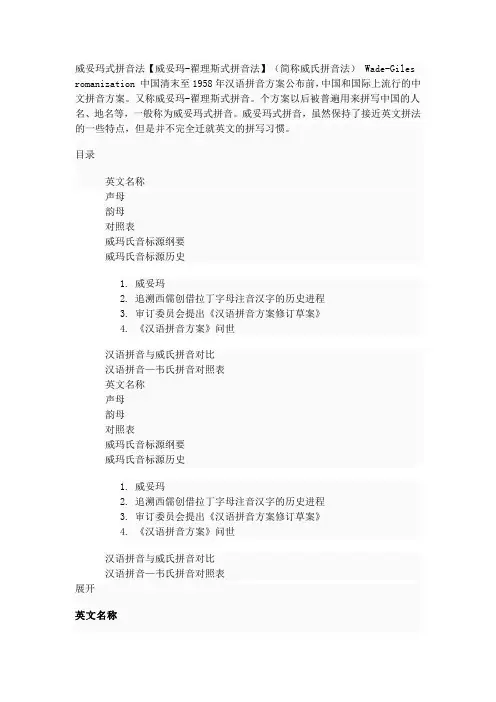
romanization 中国清末至1958年汉语拼音方案公布前,中国和国际上流行的中文拼音方案。
又称威妥玛-翟理斯式拼音。
个方案以后被普遍用来拼写中国的人名、地名等,一般称为威妥玛式拼音。
威妥玛式拼音,虽然保持了接近英文拼法的一些特点,但是并不完全迁就英文的拼写习惯。
目录英文名称声母韵母对照表威玛氏音标源纲要威玛氏音标源历史1.威妥玛2.追溯西儒创借拉丁字母注音汉字的历史进程3.审订委员会提出《汉语拼音方案修订草案》4.《汉语拼音方案》问世汉语拼音与威氏拼音对比汉语拼音—韦氏拼音对照表英文名称声母韵母对照表威玛氏音标源纲要威玛氏音标源历史1.威妥玛2.追溯西儒创借拉丁字母注音汉字的历史进程3.审订委员会提出《汉语拼音方案修订草案》4.《汉语拼音方案》问世汉语拼音与威氏拼音对比汉语拼音—韦氏拼音对照表展开英文名称Wade-Giles romanizationT.F.威妥玛(Thomas Francis Wade1818~1895),英国人。
从1841年起在英国驻华使馆任职。
1871年升为英国驻华公使。
1883年回国。
1888年起在剑桥大学任教授,讲授汉语,直至1895年逝世。
威妥玛在华任职期间,使用他根据北京读书音制订的拉丁字母拼音方案给汉字注音。
这它的最大缺点是没有充分考虑汉语的语音特点,拘泥于国际习惯,沿袭了前人使用送气符号来表示声母的办法。
在实际应用中,送气符号常常被省略,因而造成很大的混乱。
声母p ㄅ p` ㄆm ㄇ f ㄈt ㄉ t` ㄊn ㄋ l ㄌk ㄍ k` ㄎng 兀h ㄏch(i) ㄐch`(i) ㄑhs ㄒch ㄓch` ㄔsh ㄕ j ㄖts, tz ㄗ ts`, tz` ㄘs, sz ㄙ注﹕tz, tz`, sz只用在空韵前。
如兹﹑雌﹑思等。
韵母i, yi ㄧu, wu ㄨ , y ㄩa ㄚ ia, ya ㄧㄚua, wa ㄨㄚo ㄛ io, yo ㄧㄛuo, wo ㄨㄛ o, yo ㄩㄛㄜieh, yeh ㄧㄝ eh, yeh ㄩㄝai ㄞuai, wai ㄨㄞei ㄟui, wei ㄨㄟao ㄠiao, yao ㄧㄠou ㄡiu, yu ㄧㄡan ㄢien, yen ㄧㄢuan, wan ㄨㄢ an, yan ㄩㄢn ㄣ in, yin ㄧㄣ un, wn ㄨㄣn, yn ㄩㄣang ㄤiang, yang ㄧㄤ uang, wang ㄨㄤng ㄥing, ying ㄧㄥ ung, wng ㄨㄥiung, yung ㄩㄥrh ㄦih (ㄓ行韵母)(ㄗ行韵母)注﹕第二种拼法为前无声母时使用。
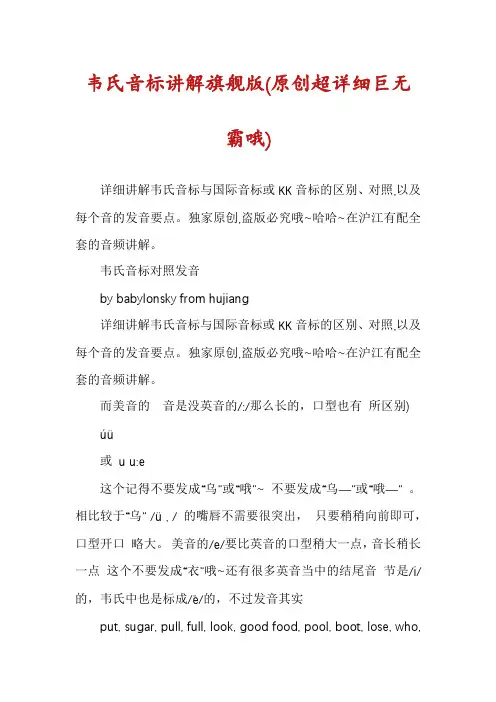
韦氏音标讲解旗舰版(原创超详细巨无霸哦)详细讲解韦氏音标与国际音标或KK音标的区别、对照,以及每个音的发音要点。
独家原创,盗版必究哦~哈哈~在沪江有配全套的音频讲解。
韦氏音标对照发音by babylonsky from hujiang详细讲解韦氏音标与国际音标或KK音标的区别、对照,以及每个音的发音要点。
独家原创,盗版必究哦~哈哈~在沪江有配全套的音频讲解。
而美音的音是没英音的/:/那么长的,口型也有所区别)úü或u u:e这个记得不要发成“乌”或“哦”~ 不要发成“乌―”或“哦―” 。
相比较于“乌” /ü , / 的嘴唇不需要很突出,只要稍稍向前即可,口型开口略大。
美音的/e/要比英音的口型稍大一点,音长稍长一点这个不要发成“衣”哦~还有很多英音当中的结尾音节是/i/的,韦氏中也是标成/ē/的,不过发音其实put, sugar, pull, full, look, good food, pool, boot, lose, who,two, blue, do pen, yes, spell, friend, parenteēi:差不多啦,美音本来也没把长短音像英音那样区分得明显。
美国人更倾向于把长短元音分别称为tense vowels 和lax vowels,以发音时面部肌肉的紧张程度来给元音分类。
美音的/a/要比英音的口型稍小一点,音长比较长参见前面的解说。
一般发这个音的是原英音中发each, easy, tree, country, marry variousaat, ash, pat:成/ /的音,没有英音的/:/那么硬,也没那么长,口型主要是上下开口比较大,左右咧开没有英音那么大。
āmop, policy, sorry, hot, fatherei美音的ā 没有像英音那样有从 e 滑到i 的双元音感觉英音中发成/:/的并且带了字母r 的在美音中都是发成带卷舌的/r/take, make, safe park, smart, car, heart murder, earth, curse, merge or, short, four, floor, war town, down, found, how kitten, button, martin, mountain, curtainr:(r) :(r) 或:(r) :(r)r英音中发成/ :/的并且带了字母r 的在美音中都是发成带卷舌的/ r/ 英音中发成/ :/的并且带了字母r 的在美音中都是发成带卷舌的/ r/ 美音的aú是+ú 很特殊的音!号称鼻腔爆破音,还是比较形象的。
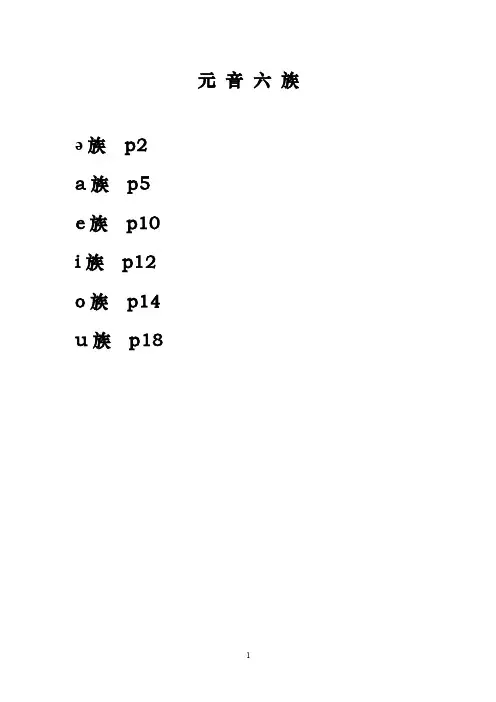
元音六族ə族p2a族p5e族p10i族p12o族p14u族p18ə族in unstressed syllables as in b a nan a, c o llide, a but(出现在非重读音节中)This neutral vowel, called schwa, (属于中性元音)may be represented orthographically by any of the letters a, e, i, o, u, y, and by many combinations of letters. (a, e, i, o, u, y都可能发这个音)In running speechunstressed vowels are regularly pronounced as in American and British speech.(在快速英语中,非重读的元音基本都发这个音)Speakers of r-dropping dialects will often insert an \r\after when precedes another vowel. (See the section on \r\.)in stressed syllables as in h u mdr u m, ab u t.(在重读音节中)Some speakers pronounce and identically before, with the result that word pairs like gull and goal are homophones.The sound produced in such cases is usually thesame sound that other speakers use forimmediately preceding as inbatt le,cott on, and one pronunciation of op en and ofand as in one pronunciation of the phrase lock and keyThe symbol preceding these consonants does not itself represent a sound. It signifies instead that the following consonant is syllabic; that is, the consonant itself forms the nucleus of a syllable that does not contain a vowel.(在辅音前的这个音标并不发声,他表示后面的辅音是主音,也就是说辅音成为这个音节的核心)In the pronunciation of some French or French-derivedwords is placed immediately after to indicate one nonsyllabic pronunciation of these consonants, asin the French words andtitre each of which in isolation and in some contexts is a one-syllable word.as in further, merger, bird . (See the section on \r\.) Actually, this is usually a single sound, not asequence of followed by (这是一个单独的发音,不是先后念出两个发音)Speakers of r-dropping dialects will pronouncewithout r-color (IPA when stressed, when unstressed) when it precedes a consonant or pause, but willinsert a following when precedes another vowel.as in two different pronunciations ofhurry. Most U.S. speakers pronounce with therepresenting the same sounds as in bird Usually in metropolitan New York and southern England and frequently in New England and the southeastern U.S. the vowel is much the same as the vowel of hum followed by a syllable-initial varietyof This pronunciation of hurry is represented asin this book.大多数都读纽约、东南部读Both types of pronunciation are shown for words composed of a single meaningful unit (or morpheme) as in current, hurry, and worry. In words such as furry, stirring,and purring in which a vowel or vowel-initial suffix is added to a word ending in(as fur, stir, and purr), the second type of pronunciationoutlined above is heard only occasionally and is not shown inthis dictionary. (r或者rr后面接元音,一般为)a族as in m a t, m a p, m a d, g a g, sn a p, p a tch .Some variation in this vowel is occasioned by the consonant that follows it; thus, for some speakers map,mad, and gag have noticeably different vowel sounds.There is a very small number of words otherwise identical in pronunciation that these speakers may distinguish solely by variation of this vowel, as in the two words can (put into cans; be able) in the sentence “Let’s can what we can.”However, this distinction is sufficiently infrequent that the traditional practice of using a single symbol is followed in this book.(“Let’s can what we can.”中是两种发音,但极少出现)Many varieties of English do not allow to be followed by an \r\ which begins the following syllable. In such a case, the sequence of \a-r\ is replaced by \er\, and word pairs like arrow and aero are homophones. This is not always indicated in transcription. The reader should assume that any sequences of\a-r\ will be \er\ for such speakers.(有的人不允许后面跟个\r\,索性\a-r\就念成\er\)When it precedes\a\ is often followed by a \y\ sound.The resulting vowel sounds much like for many speakers.as in d a y, f a de,d a te,a orta,dr a pe,c a peIn most English speech this is actually a diphthong.(多数人认为是双元音)In lowland South Carolina, in coastalGeorgia and Florida, and occasionally elsewhere is pronounced as a monophthong.(但是在南卡罗来纳低地、佐治亚、弗罗里达海岸,偶尔在其他地区,被念成单元音)Asa diphthong has a first element \e\ or monophthongaland a second element \i\.Before \l\, speakers may lose the second element \i\ andinsert Thus, a word like ale would be Alternately, many speakers will keep the second element \i\ andadd a following which creates a new syllable. Thus, theword trail will be rhyming with betrayal.(在\l\前面时,有的会把\i\变成,有的会再后面加个)as in bother, cot. The symbol \ä\ represents the vowel of cot, cod, and the stressed vowel of collar in the speech of those who pronounce this vowel differently from the vowel in caught, cawed, and caller, represented by (和发音因该是不同的)In U.S. speech \ä\ is pronounced with little or no rounding of the lips, and it is fairly long in duration, especiallybefore voiced consonants. (在美国,的发音嘴唇不是圆的,持续时间相当长,特别是在浊辅音前面)In southern England \ä\ is usually accompanied by some lip rounding and is relatively short in duration. (在南英格兰,\ä\的发音嘴唇是圆的,持续时间很短)The vowel generally has appreciable liprounding.(的发音嘴唇是圆的)Many U.S. speakers do not distinguish between cot-caught, cod-cawed, and collar-caller, usually because they lack or have less lip rounding in the wordstranscribed with(很多美国人区分不出来和,通常是因为他们缺少或只有很少地把嘴唇变圆)Though the symbols \ä\ and are used throughout this book to distinguish the members of the above pairs and similarwords, (在这本书中,和这两符号就是用来区分这样成对或者近似的单词)the speakers who rhyme these pairs will automatically reproduce a sound that is consistent with their own speech.(如果为了押韵,人们会自动地复制某一个发音,来押韵。

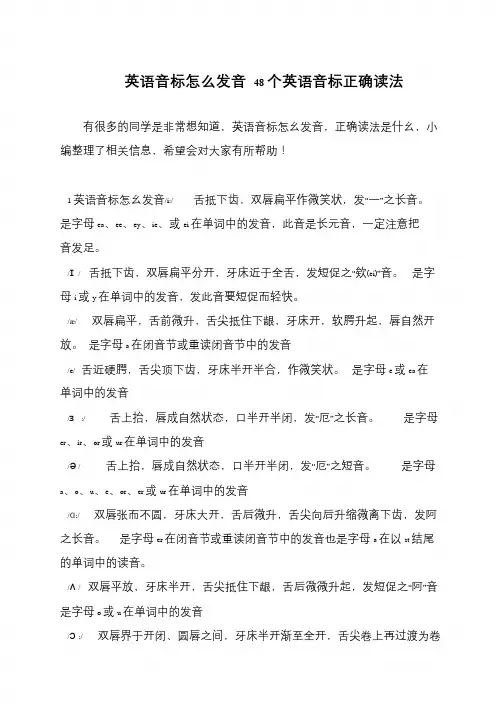
英语音标怎么发音48 个英语音标正确读法
有很多的同学是非常想知道,英语音标怎幺发音,正确读法是什幺,小编整理了相关信息,希望会对大家有所帮助!
1 英语音标怎幺发音/i:/ 舌抵下齿,双唇扁平作微笑状,发“一”之长音。
是字母ea、ee、ey、ie、或ei 在单词中的发音,此音是长元音,一定注意把
音发足。
/ɪ/舌抵下齿,双唇扁平分开,牙床近于全舌,发短促之“欸(ei)”音。
是字母i 或y 在单词中的发音,发此音要短促而轻快。
/æ/ 双唇扁平,舌前微升,舌尖抵住下龈,牙床开,软腭升起,唇自然开放。
是字母a 在闭音节或重读闭音节中的发音
/e/ 舌近硬腭,舌尖顶下齿,牙床半开半合,作微笑状。
是字母e 或ea 在单词中的发音
/з:/舌上抬,唇成自然状态,口半开半闭,发“厄”之长音。
是字母er、ir、or 或ur 在单词中的发音
/ə/舌上抬,唇成自然状态,口半开半闭,发“厄”之短音。
是字母a、o、u、e、or、er 或ur 在单词中的发音
/ɑ:/双唇张而不圆,牙床大开,舌后微升,舌尖向后升缩微离下齿,发阿之长音。
是字母er 在闭音节或重读闭音节中的发音也是字母a 在以st 结尾的单词中的读音。
/ʌ/双唇平放,牙床半开,舌尖抵住下龈,舌后微微升起,发短促之“阿”音是字母o 或u 在单词中的发音
/ɔ:/双唇界于开闭、圆唇之间,牙床半开渐至全开,舌尖卷上再过渡为卷。
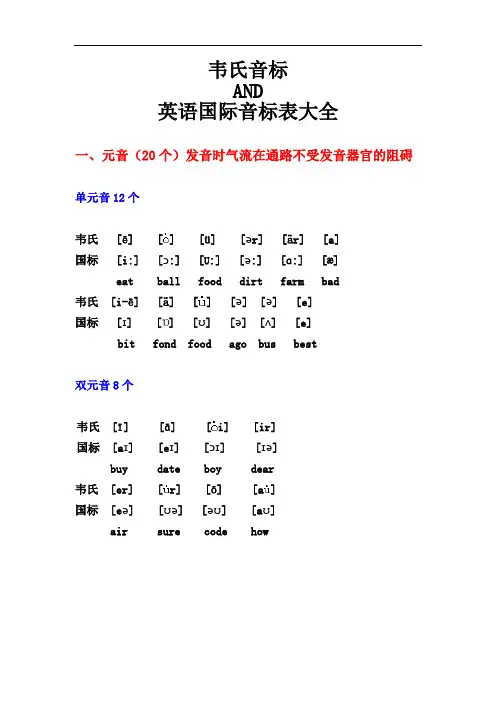
韦氏音标AND英语国际音标表大全一、元音(20个)发音时气流在通路不受发音器官的阻碍单元音12个韦氏 [ē] [] [ü] [ər] [är] [a]国标 [i:] [ɔ:] [U:] [ə:] [ɑ:] [æ]eat ball food dirt farm bad韦氏 [i-ē] [ä] [] [ə] [ə] [e]国标 [ɪ] [ɒ] [ʊ] [ə] [ʌ] [e]bit fond food ago bus best双元音8个韦氏 [ī] [ā] [i] [ir]国标 [aɪ] [eɪ] [ɔɪ] [ɪə]buy date boy dear韦氏 [er] [r] [ō] [a]国标 [eə] [ʊə] [əʊ] [aʊ]air sure code how二、辅音(26个)发音时气流在通路上受到发音器官的阻碍轻辅音韦氏 [p] [t] [k] [f] [th] [s] [sh-k] [ch] [ts] [tr] 国标 [p] [t] [k] [f] [θ] [s] [ʃ] [tʃ] [ts] [tr]浊辅音韦氏 [b] [d] [g] [v] [th] [z] [zh] [j] [dz] [dr]国标 [b] [d] [g] [v] [ð] [z] [ʒ] [dʒ] [dz] [dr]鼻音韦氏 [m] [n] [ŋ]国标 [m] [n] [ŋ]边音韦氏 [h] [r] [y] [w]国标 [h] [r] [j] [w]舌侧音韦氏 [l]国标 [l]半元音韦氏 [y] [w] 国标 [j] [w]其他分法1、前元音 4个韦氏 [ē] [i-ē] [e] [a]国际 [i:] [ɪ] [e] [æ]2、中元音3个韦氏 [ər] [ə] [ə]国际 [ə:] [ə] [ʌ]3、后元音5个韦氏 [är] [ä] [] [] [ü] 国际 [ɑ:] [ɒ] [ɔ:] [ʊ] [U:]4、合口双元音5个韦氏 [ī] [i] [ā] [a] [ō] 国际 [aɪ] [ɔɪ] [eɪ] [aʊ] [əʊ]5、集中双元音3个韦氏 [ir] [e r] [r]国际 [ɪə] [eə] [ʊə]6、爆破辅音6个韦氏 [p] [b] [t] [d] [k] [g]国际 [p] [b] [t] [d] [k] [g]7、摩擦辅音4个韦氏 [f] [v] [s] [z]国际 [f] [v] [s] [z]8、摩擦辅音4个韦氏 [th] [th] [sh-k] [zh]国际 [θ] [ð] [ʃ] [ʒ]9、鼻辅音3个韦氏 [m] [n] [ŋ]国际 [m] [n] [ŋ]10、破擦音6个韦氏 [ch] [tr] [ts] [j] [dr] [dz] 国际 [tʃ] [tr] [ts] [dʒ] [dr] [dz]11、舌侧音1个韦氏 [l]国际 [l]12、摩擦音2个韦氏 [r] [h]国际 [r] [h]13、半元音2个韦氏 [w] [y]国际 [w] [j]巧记48个国际音标单元音共十二,四二六前中后。
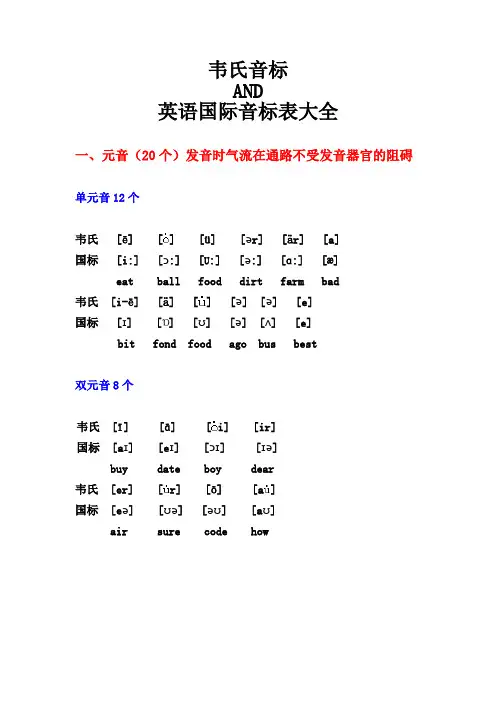
韦氏音标AND英语国际音标表大全一、元音(20个)发音时气流在通路不受发音器官的阻碍单元音12个韦氏 [ē] [] [ü] [ər] [är] [a]国标 [i:] [ɔ:] [U:] [ə:] [ɑ:] [æ]eat ball food dirt farm bad韦氏 [i-ē] [ä] [] [ə] [ə] [e]国标 [ɪ] [ɒ] [ʊ] [ə] [ʌ] [e]bit fond food ago bus best双元音8个韦氏 [ī] [ā] [i] [ir]国标 [aɪ] [eɪ] [ɔɪ] [ɪə]buy date boy dear韦氏 [er] [r] [ō] [a]国标 [eə] [ʊə] [əʊ] [aʊ]air sure code how二、辅音(26个)发音时气流在通路上受到发音器官的阻碍轻辅音韦氏 [p] [t] [k] [f] [th] [s] [sh-k] [ch] [ts] [tr] 国标 [p] [t] [k] [f] [θ] [s] [ʃ] [tʃ] [ts] [tr]浊辅音韦氏 [b] [d] [g] [v] [th] [z] [zh] [j] [dz] [dr]国标 [b] [d] [g] [v] [ð] [z] [ʒ] [dʒ] [dz] [dr]鼻音韦氏 [m] [n] [ŋ]国标 [m] [n] [ŋ]边音韦氏 [h] [r] [y] [w]国标 [h] [r] [j] [w]舌侧音韦氏 [l]国标 [l]半元音韦氏 [y] [w] 国标 [j] [w]其他分法1、前元音 4个韦氏 [ē] [i-ē] [e] [a]国际 [i:] [ɪ] [e] [æ]2、中元音3个韦氏 [ər] [ə] [ə]国际 [ə:] [ə] [ʌ]3、后元音5个韦氏 [är] [ä] [] [] [ü] 国际 [ɑ:] [ɒ] [ɔ:] [ʊ] [U:]4、合口双元音5个韦氏 [ī] [i] [ā] [a] [ō] 国际 [aɪ] [ɔɪ] [eɪ] [aʊ] [əʊ]5、集中双元音3个韦氏 [ir] [e r] [r]国际 [ɪə] [eə] [ʊə]6、爆破辅音6个韦氏 [p] [b] [t] [d] [k] [g]国际 [p] [b] [t] [d] [k] [g]7、摩擦辅音4个韦氏 [f] [v] [s] [z]国际 [f] [v] [s] [z]8、摩擦辅音4个韦氏 [th] [th] [sh-k] [zh]国际 [θ] [ð] [ʃ] [ʒ]9、鼻辅音3个韦氏 [m] [n] [ŋ]国际 [m] [n] [ŋ]10、破擦音6个韦氏 [ch] [tr] [ts] [j] [dr] [dz] 国际 [tʃ] [tr] [ts] [dʒ] [dr] [dz]11、舌侧音1个韦氏 [l]国际 [l]12、摩擦音2个韦氏 [r] [h]国际 [r] [h]13、半元音2个韦氏 [w] [y]国际 [w] [j]巧记48个国际音标单元音共十二,四二六前中后。
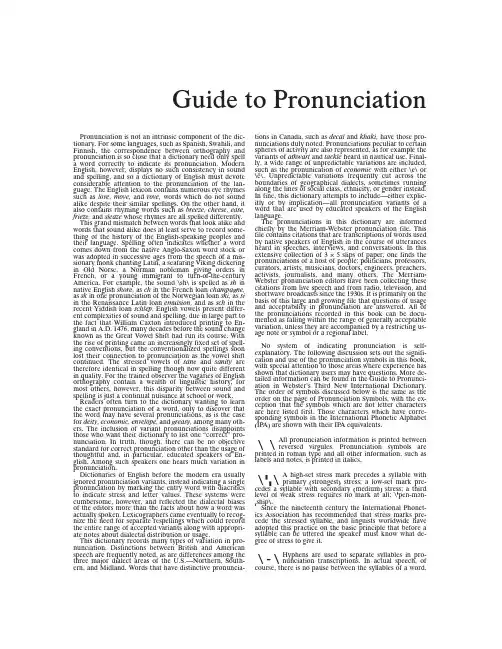
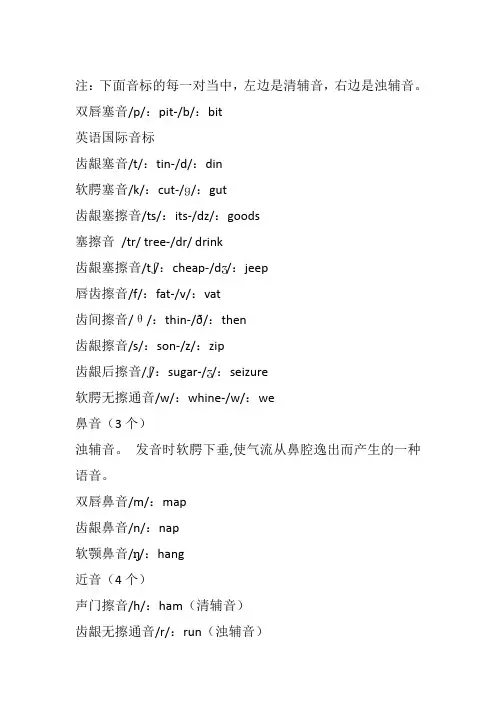
注:下面音标的每一对当中,左边是清辅音,右边是浊辅音。
双唇塞音/p/:pit-/b/:bit英语国际音标齿龈塞音/t/:tin-/d/:din软腭塞音/k/:cut-/ɡ/:gut齿龈塞擦音/ts/:its-/dz/:goods塞擦音/tr/ tree-/dr/ drink齿龈塞擦音/tʃ/:cheap-/dʒ/:jeep唇齿擦音/f/:fat-/v/:vat齿间擦音/θ/:thin-/ð/:then齿龈擦音/s/:son-/z/:zip齿龈后擦音/ʃ/:sugar-/ʒ/:seizure软腭无擦通音/w/:whine-/w/:we鼻音(3个)浊辅音。
发音时软腭下垂,使气流从鼻腔逸出而产生的一种语音。
双唇鼻音/m/:map齿龈鼻音/n/:nap软颚鼻音/ŋ/:hang近音(4个)声门擦音/h/:ham(清辅音)齿龈无擦通音/r/:run(浊辅音)齿龈边音/l/:left(浊辅音)软腭化齿龈边音/ɫ/:cancel(浊辅音)半元音(3个)语音学上指擦音中气流较弱,摩擦较小,介于元音跟辅音之间的音。
软腭无擦通音/ʍ/:whine(也写成/hw/,仅用于美语)-/w/:we硬腭无擦通音/j/:yes(浊辅音)成音节辅音几/:bottle/:button/:rhythm几种常见的音位变体1.齿音闪音[ɾ]:better,city,writing(浊辅音;非词首、非重读音节t的发音;多见于北美与澳洲英语)2.喉塞音[ʔ]:curtain,botton(清辅音;非词首、非重读音节/t/与/n/构成成音节时,字母t的发音;多见北美英语、Eastury 英语和Cockney英语),(ʔ)uh-(ʔ)oh3.如果清爆破音位于s后面,且处于词首或者是非重读音节的话,通常不送气(类似于汉语拼音的b,d,g)。
种常见的音位变体1.齿音闪音[ɾ]:better,city,writing(浊辅音;非词首、非重读音节t的发音;多见于北美与澳洲英语)2.喉塞音[ʔ]:curtain,botton(清辅音;非词首、非重读音节/t/与/n/构成成音节时,字母t的发音;多见北美英语、Eastury 英语和Cockney英语),(ʔ)uh-(ʔ)oh3.如果清爆破音位于s后面,且处于词首或者是非重读音节的话,通常不送气(类似于汉语拼音的b,d,g)。
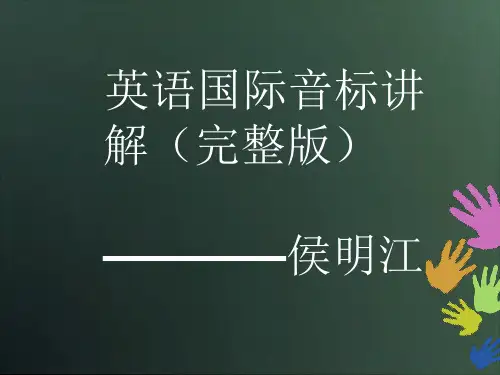
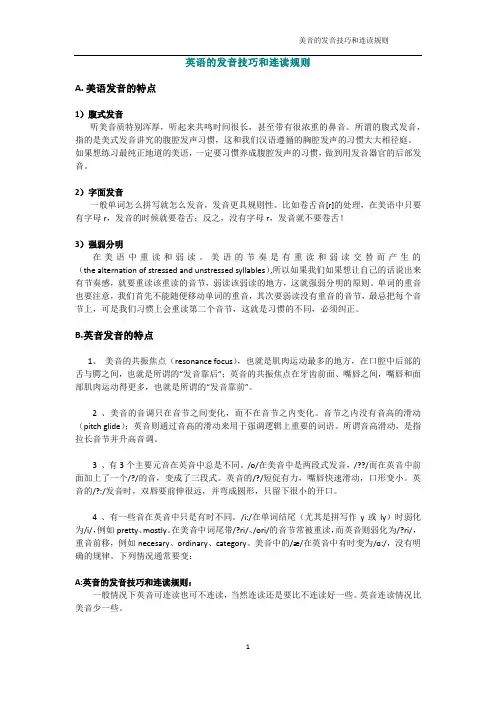
英语的发音技巧和连读规则A.美语发音的特点1)腹式发音听美音质特别浑厚,听起来共鸣时间很长,甚至带有很浓重的鼻音。
所谓的腹式发音,指的是美式发音讲究的腹腔发声习惯,这和我们汉语遵循的胸腔发声的习惯大大相径庭。
如果想练习最纯正地道的美语,一定要习惯养成腹腔发声的习惯,做到用发音器官的后部发音。
2)字面发音一般单词怎么拼写就怎么发音,发音更具规则性。
比如卷舌音[r]的处理,在美语中只要有字母r,发音的时候就要卷舌;反之,没有字母r,发音就不要卷舌!3)强弱分明在美语中重读和弱读。
美语的节奏是有重读和弱读交替而产生的(the alternation of stressed and unstressed syllables),所以如果我们如果想让自己的话说出来有节奏感,就要重读该重读的音节,弱读该弱读的地方,这就强弱分明的原则。
单词的重音也要注意,我们首先不能随便移动单词的重音,其次要弱读没有重音的音节,最忌把每个音节上,可是我们习惯上会重读第二个音节,这就是习惯的不同,必须纠正。
B.英音发音的特点1、美音的共振焦点(resonance focus),也就是肌肉运动最多的地方,在口腔中后部的舌与腭之间,也就是所谓的“发音靠后”;英音的共振焦点在牙齿前面、嘴唇之间,嘴唇和面部肌肉运动得更多,也就是所谓的“发音靠前”。
2、美音的音调只在音节之间变化,而不在音节之内变化。
音节之内没有音高的滑动(pitch glide);英音则通过音高的滑动来用于强调逻辑上重要的词语。
所谓音高滑动,是指拉长音节并升高音调。
3、有3个主要元音在英音中总是不同。
/o/在美音中是两段式发音,/??/而在英音中前面加上了一个/?/的音,变成了三段式。
英音的/?/短促有力,嘴唇快速滑动,口形变小。
英音的/?:/发音时,双唇要前伸很远,并弯成圆形,只留下很小的开口。
4、有一些音在英音中只是有时不同。
/i:/在单词结尾(尤其是拼写作y或ly)时弱化为/i/,例如pretty、mostly。
英语音标学习软件推荐音标app软件哪个最好
很多人想知道学英语音标可以用哪个软件,哪个音标软件最好呢?下面小编为大家介绍一下!
英语音标学习软件哪个最好1、我爱学音标:爱学音标能够帮助你学习和
掌握英语48个音标的读音,帮助你更高好学习和朗读标准读音的英语单词。
是一款方便易用的英语读音器。
提供多种学习方法,内涵音标联系、听写拼写、习题复习等功能来帮助你巩固自己的学习。
内置音标字典,可以根据发音查单词,哪怕音标记不太清楚也能查到。
全音标真人发音,附带讲解和口形图,让你学的更加全面,是你学习英语的必备利器。
2、多邻国:路易斯•冯•安成功地抓住了现代人热衷学习的心理,把游戏化结合在语言学习中,推出了这款目前用户已经突破一亿的APP。
毫不夸张的说,Duolingo已经成为了移动端语言学习的标杆。
3、Busuu(博树):提供12门语言的所有课程。
这款应用可以免费下载,但是要体验完整版的功能和课程资源,你需要付费才能解锁,费用是一个月17美元。
在Busuu,语言学习从单个单词开始,慢慢过渡到对话、对对话的提问。
不管是单词、对话还是提问,都有对应的母语朗读音频供学习者学习。
音标app软件排行榜音标查字
不论是做听写,还是一般的泛听,相信大家都时常会碰到这样的尴尬:有时候一个词的发音听得很清楚,却不知道到底是什幺词,甚至有些词根据发音的规律也拼不出来。
前段时间我偶然发现了这个软件,发现它在解决这个问题上效果挺不错的。
大家可以根据你听到的词的发音,输入大致的音标,一般就可以把这个生词。
威玛氏音标威玛氏音标,在1958年大陆推广汉语拼音方案前广泛被用于人名、地名注音,影响较大(中国台湾地区至今仍在使用)。
1958年后,逐渐废止。
现在中国大陆除了少数需要保持文化传统的场合外,基本不用,北京大学、清华大学,中山大学,苏州大学等学校还使用韦氏音标法的英文校名,而大多数地名、人名已使用汉语拼音。
【汉语拼音与威氏拼音对比】方括号里的是汉语拼音。
它左边的是此汉语拼音的威氏拼音。
p p'[p] m[m] f[f]t[d] t'[t] n [n] l [l]k [g] k'[k] h [h]ch[j] ch' [q] hs[x]ch[zh] ch'[ch] sh[sh] j[r]ts tz [z] ts' tz'[c] s ss sz [s]y [y] w [w]a[a] o[o] ê[e] eh[ê] êrh [er]ih[-i1] ǔ[-i2]i u[u] ǖ [ǖ]ai[ai] ei[ei] ao[ao] ou[ou]an[an] ên[en] ang [ang] êng [eng]ia[ia] io[io] ieh [ie] iao [iao] iu[iou]ien [ian] in[in] iang[iang] ing [ing]ua[ua] uo[uo] uai [uai] uei ui[ui]uan [uan] un[un] uang[uang] ung [ong]ǖeh [ǖ] ǖan [ǖan] ǖn[ǖn] iung[iong]汉语拼音—韦氏拼音对照表Pinyin to Wade-Giles Conversion TableWade-Giles pinyina a ai ai an an ang ang ao ao cha zha ch'a cha chai zhai ch'ai chai chan zhanch'an chan chang zhangch'ang changchao zhaoch'ao chaoche zhech'e che chen zhench'en chen cheng zhengch'eng chengchi jich'i qi chia jiach'ia qiachiang jiangch'iang qiangchiao jiaoch'iao qiao chieh jie ch'ieh qie chien jian ch'ien qian chih zhi ch'ih chi chin jin ch'in qin ching jingch'ing qing chiu jiu ch'iu qiu chiung jiongch'iung qiongcho zhuoch'o chuo chou zhouch'ou chouchu zhuch'u chuchü juch'ü quchua zhuachuai zhuaich'uai chuaichuan zhuanch'uan chuanchüan juanch'üan quanchuang zhuangch'uang chuang chüeh juech'üeh que chui zhuich'ui chui chun zhunch'un chunchün junch'ün qun chung zhongch'ung chong en enerh erfa fafan fanfang fangfei feifen fenfeng fengfo fofou foufu fuha hahai haihan hanhang hanghao haohei heihen henheng hengho hehou houhsi xihsia xia hsiang xiang hsiao xiao hsieh xie hsien xian hsin xin hsing xing hsiu xiu hsiung xiong hsü xuhsüan xuan hsüeh xuehsün xunhu huhua huahuai huai huan huan huang huang hui huihun hun hung hong huo huoi yijan ranjang rang jao raoje rejen renjeng rengjih rijo ruojou rouju rujuan ruan jui rui jun run jung rong ka gak'a kakai gaik'ai kai kan gank'an kan kang gang k'ang kang kao gaok'ao kao ken genk'en ken keng geng k'eng keng ko gek'o kekou gouk'ou kou ku guk'u kukua guak'ua kua kuai guaik'uai kuai kuan guank'uan kuan kuang guang k'uang kuang kuei guik'uei kui kun gunk'un kun kung gong k'ung kong kuo guok'uo kuola lalai lailan lanlang lang lao laole lelei leileng lengli liliang liang liao liao lieh lielien lianlin linling lingliu liulo luolou loulu lulü lü luan luan lüan luan lüeh lue lun lun lung long ma mamai mai man man mang mang mao mao mei mei men men meng meng mi mi miao miao mieh mie mien mian min min ming ming miu miu mo mo mou mou mu muna nanai nai nan nan nang nang nao nao nei neineng neng ni niniang niang niao niao nieh nie nien nian nin nin ning ning niu niuno nuonou nounu nunü nünuan nuan nüeh nue nung nong o eou oupa bap'a papai baip'ai pai pan banp'an pan pang bang p'ang pang pao baop'ao pao pei beip'ei peip'en pen peng beng p'eng peng pi bip'i pi piao biao p'iao piao pieh bie p'ieh pie pien bian p'ien pian pin binp'in pin ping bing p'ing ping po bop'o pop'ou pou pu bup'u pusa sasai sai san san sang sang sao saose sesen sen seng seng sha sha shai shaishang shang shao shaoshe sheshen shen sheng sheng shih shi shou shoushu shushua shua shuai shuai shuan shuan shuang shuang shui shui shun shun shuo shuoso suosou soussu sisu susuan suansui suisun sunsung songta dat'a tatai dait'ai taitan dant'an tantang dangtao daot'ao tao te det'e te teng deng t'eng teng ti dit'i titiao diao t'iao tiao tieh die t'ieh tie tien dian t'ien tian ting ding t'ing ting tiu diuto duot'o tuo tou dout'ou tou tu dut'u tu tuan duan t'uan tuan tui duit'ui tui tun dunt'un tun tung dongtsa zats'a catsai zaits'ai cai tsan zants'an can tsang zang ts'ang cang tsao zaots'ao cao tse zets'e cetsei zei tsen zents'en cen tseng zeng ts'eng ceng tso zuots'o cuo tsou zouts'ou cou tsu zuts'u cu tsuan zuan ts'uan cuan tsui zuits'ui cui tsun zunts'un cun tsung zongtzu zitz'u ci wa wawai wai wan wan wang wang wei wei wen wen weng weng wo wowu wuya yayai yai yang yang yao yao yeh ye yen yan yin yin ying ying yo yoyu youyü yuyüan yuan yüeh yue yün yun yung yong。
文章标题:海伦英语音标入门:48个音标读法详解一、海伦英语音标入门在学习英语发音的过程中,海伦英语音标是一个非常重要的工具。
海伦英语音标以其简单易学的特点,帮助许多英语学习者正确地发音。
今天,我们将深入探讨海伦英语音标的48个音标读法,帮助大家更好地掌握英语发音。
二、48个音标读法详解1. /i:/ 音标读法:[i:]/i:/ 音标是一个长元音,发音时嘴唇微微张开,舌尖抵住下齿,舌尖抬高,发出/i:/这个音。
2. /e/ 音标读法:[e]/e/ 音标是一个短元音,发音时嘴巴微微张开,舌尖抵住下齿,舌头略微抬高,发出/e/这个音。
3. /æ/ 音标读法:[æ]/æ/ 音标是一个短元音,发音时嘴唇微微张开,舌头放平,发出/æ/这个音。
4. /ʌ/ 音标读法:[ʌ]/ʌ/ 音标是一个短元音,发音时嘴唇微微张开,舌头放平,舌尖抵住下齿,发出/ʌ/这个音。
5. /ɜ:/ 音标读法:[ɜ:]/ɜ:/ 音标是一个长元音,发音时嘴唇微微张开,舌头放平,发出/ɜ:/这个音。
6. /ɔ:/ 音标读法:[ɔ:]/ɔ:/ 音标是一个长元音,发音时嘴唇微微张开,舌头放平,舌尖向后抬起,发出/ɔ:/这个音。
7. /u:/ 音标读法:[u:]/u:/ 音标是一个长元音,发音时嘴唇收口,舌头抵住下齿,舌尖向上抬起,发出/u:/这个音。
8. /ʊ/ 音标读法:[ʊ]/ʊ/ 音标是一个短元音,发音时嘴唇收口,舌头抵住下齿,舌尖向上抬起,发出/ʊ/这个音。
9. /ɑ:/ 音标读法:[ɑ:]/ɑ:/ 音标是一个长元音,发音时嘴唇微微张开,舌头放平,发出/ɑ:/这个音。
10. /ɪ/ 音标读法:[ɪ]/ɪ/ 音标是一个短元音,发音时嘴唇微微张开,舌尖抵住下齿,舌头略微抬高,发出/ɪ/这个音。
11. /eɪ/ 音标读法:[eɪ]/eɪ/ 音标是一个双元音,发音时先发长元音/i:/,然后迅速转成元音/e/,发出/eɪ/这个音。
\ə\ as a in about\ 'ə, ֽə\ as u in abut \ ən \ as en in kitten \ r \ as ur\er in further \ a \ as a in ash\ ā \ as a in ace\ ä \ as o in mop\ aů \ as ou in out\ b \ as b in baby\ ch \ as ch in chin\ d \ as d in did\ e \ as e in bet\ 'ē, ֽē\ as ea in easy \ ē \ as y in easy\ f \ as f in fifty\ g \ as g in go\ h \ as h in hat\ i \ as i in hit\ ī \ as i in ice\ j \ as j in job\ k \ as k in kin\ k \ as ch in children \ l \ as l in lily\ m \ as m in murmur \ n \ as n in own\ ŋ\ as ng in sing\ ō \ as o in go\ ό \ as aw in law\ όi \ as oy in boy\ p \ as p in pepper \ r \ as r in red\ s \ as s in less\ sh \ as sh in shy\ t \ as t in tie\ th \ as th in thin\ th \ as th in the\ ü \ as oo in loot\ ů \ as oo in foot\ v \ as v in vivid\ w \ as w in away\ y \ as y in yet\ yü \ as you in youth \ y \ as u in curable \ z \ as z in zone\\ zh \ as si in vision这套音标系统里面没有国际音标中\tr\, \dr\, \ts\, \dz\的对应音标,因为现代语音学认为这四个音标不是独立因素,而属于辅音连缀。